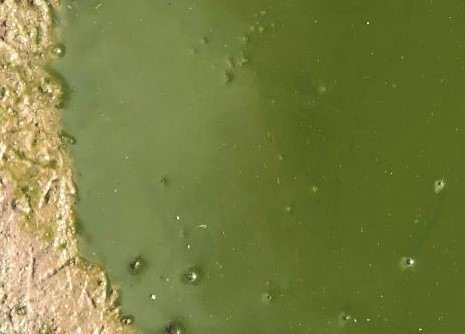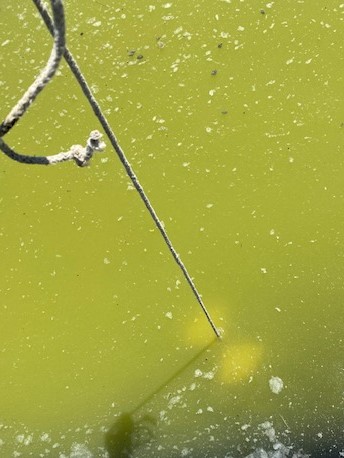Planktonic algae, otherwise known as phytoplankton, are microscopic, single celled, free floating algae that can exist wherever the sun penetrates. Planktonic algae thrive under sunny conditions at water temperatures greater than 60°F, and contributes to water’s greenish tint. Typically, planktonic algae are considered desirable as they shade the pond bottom which suppresses the establishment of rooted aquatic plants, are the foundation of a pond’s food chain by providing food for zooplankton and larval fishes, and provides 80% of the oxygen in the water.
However, an overabundance of planktonic algae, called “Blooms” – particularly their eventual death – can lead oxygen depletions, and eventually fish kills. Planktonic algae can die-off naturally and rapidly due to cloudy days and cold snaps during rain events or colder months. After the algae cells die, they begin to lose their chlorophyll and green coloration. This is why a tell-tale sign of a die-off is a change in water color, in streaks or entirely, from green to brick-red, brown, or black, and can give off a foul odor. Ultimately, these dead cells will settle to the pond’s bottom, giving the pond a clearer appearance. These dying cells are not only a nuisance aesthetically; beneficial bacteria require oxygen to break down these cells. This lowers the amount of oxygen available to fish and other aquatic organisms.
Samples that are sent in to the Aquatics Diagnostic Laboratory after a planktonic algae die-off, may contain these dead, discolored cells, which are confirmed through microscopic examination. Additionally, samples can have high total ammonia nitrogen (TAN) concentrations through the algae decomposition process. During warmer months or in high pH ponds, high TAN is a serious issue that may lead to a fish kill due to unionized ammonia (UIA) levels. UIA is toxic to fish and concentrations are dependent on TAN, temperature, and pH. Therefore, when the water temperature is cool and pH is low, high TAN levels will result in low UIA and pose little risk to fish.
Negative effects of a planktonic algae die-off can be minimized by stopping all fish feeding until spring when the water temperatures are 60°F or higher. Feeding during winter months (<60°F), when fish are eating less, can contribute to excess ammonia in the pond from protein in uneaten feed and excess protein in feces. An aerator can also be added to increase overall dissolved oxygen and reduce the chances of a potential fish kill. Regardless, stress put on fish due to decreased water quality conditions can lead to secondary diseases.
If you are concerned your planktonic algae bloom density is problematic, a secchi disk can be used to measure water clarity, which can help indicate planktonic algae levels. For more pictures and information on planktonic algae, please read Managing and Controlling Algae in Pond and visit AquaPlant.tamu.edu.


